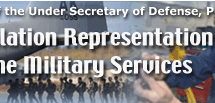| U.S. COAST GUARD
Representation Within Occupations.
The representation of USCG enlisted force by race/ethnicity and gender
in occupational areas with the overall DoD rates for comparison is presented
in Tables 7.5, 7.6 and 7.7. The USCG is unique in that there are no combat
restrictions for women. However, women were still under-represented in
the infantry, gun crews, and seamanship specialties compared to men in
the USCG (10 and 20 percent, respectively). Restructuring of the Coast
Guard’s aviation rating from late FY 1997 through FY 1999 with additional
reclassification occurring in FYs 2000 and 2002 led to some changes in
occupational area distributions. The most notable differences were an
increase in the number of positions classified as infantry, gun crews,
and seamanship with a corresponding decrease in electrical/mechanical
equipment repair. In FY 2000 there was a decrease in infantry, gun crews,
and seamanship with increases in electrical/mechanical equipment repair
and electronic equipment repair. Then, in FY 2002 there was an increase
in electrical/mechanical equipment repair with a corresponding decrease
in electronic equipment repair as the USCG moved jobs into the appropriate
occupational code to reflect updated job requirements.
| Table
7.5. Occupational Areas of FY 2004 USCG and DoD Active Component
Enlisted Personnel by Race/Ethnicity (Percent) |
| Occupational
Codes
and Areas |
Coast Guard |
DoD Total |
| White |
Black |
AIAN |
Asian |
NHPI |
Two or More |
Unknown |
Total |
| 0 |
Infantry, Gun Crews, and Seamanship
Specialists |
21.2 |
5.7 |
17.1 |
17.6 |
9.1 |
12.1 |
13.7 |
19.2 |
17.1 |
| 1 |
Electronic Equipment Repairers |
6.8 |
5.1 |
6.3 |
17.6 |
0.0 |
7.7 |
5.4 |
6.6 |
8.8 |
| 2 |
Communications and Intelligence Specialists |
0.0 |
0.0 |
0.0 |
0.0 |
0.0 |
0.0 |
0.0 |
0.0 |
9.4 |
| 3 |
Medical and Dental Specialists |
2.1 |
4.2 |
2.5 |
0.0 |
0.0 |
3.6 |
2.9 |
2.4 |
6.8 |
| 4 |
Other Allied Specialists |
6.7 |
3.7 |
8.8 |
11.8 |
9.1 |
5.8 |
4.2 |
6.3 |
2.9 |
| 5 |
Functional Support and Administration |
12.2 |
35.1 |
12.4 |
23.5 |
54.5 |
17.6 |
15.2 |
14.1 |
15.9 |
| 6 |
Electrical/Mechanical Equipment Repairers |
21.6 |
20.9 |
24.1 |
11.8 |
18.2 |
23.3 |
22.3 |
21.7 |
20.7 |
| 7 |
Craftsmen |
14.5 |
7.9 |
11.2 |
5.9 |
9.1 |
10.3 |
13.2 |
13.8 |
3.7 |
| 8 |
Service and Supply Handlers |
1.4 |
0.4 |
1.2 |
0.0 |
0.0 |
0.9 |
0.6 |
1.3 |
9.2 |
| 9 |
Non-Occupational* |
13.4 |
17.1 |
16.5 |
11.8 |
0.0 |
18.8 |
22.5 |
14.7 |
5.6 |
| Total |
100.0 |
100.0 |
100.0 |
100.0 |
0.0 |
0.0 |
100.0 |
100.0 |
100.0 |
|
| Table
7.6. Occupational Areas of FY 2004 USCG and DoD Active Component
Enlisted Personnel by Hispanic Representation (Percent) |
| Occupational
Codes and Areas |
Coast Guard |
DoD |
| Hispanic |
Not Hispanic |
|
0 |
Infantry, Gun Crews,
and Seamanship Specialists |
13.9 |
19.7 |
17.1 |
|
1 |
Electronic Equipment
Repairers |
4.3 |
6.8 |
8.8 |
|
2 |
Communications and Intelligence
Specialists |
0.0 |
0.0 |
9.4 |
|
3 |
Medical and Dental Specialists |
3.0 |
2.3 |
6.8 |
|
4 |
Other Allied Specialists |
4.0 |
6.5 |
2.9 |
|
5 |
Functional Support and
Administration |
16.0 |
13.9 |
15.9 |
|
6 |
Electrical/Mechanical
Equipment Repairers |
22.3 |
21.7 |
20.7 |
|
7 |
Craftsmen |
13.5 |
13.8 |
3.7 |
|
8 |
Service and Supply Handlers |
0.5 |
1.3 |
9.2 |
|
9 |
Non-Occupational* |
22.6 |
14.0 |
5.6 |
| Total |
100.0 |
100.0 |
100.0 |
|
| Table
7.7. Occupational Areas of FY 2004 USCG and DoD Active Component
Enlisted Personnel by Gender (Percent) |
| Occupational
Codes and Areas |
Coast
Guard |
DoD Total |
| Male |
Female |
USCG
Total |
| 0 |
Infantry, Gun Crews, and Seamanship
Specialists |
20.4 |
9.7 |
19.2 |
17.1 |
| 1 |
Electronic Equipment Repairers |
7.1 |
2.4 |
6.6 |
8.8 |
| 2 |
Communications and Intelligence Specialists |
0.0 |
0.0 |
0.0 |
9.4 |
| 3 |
Medical and Dental Specialists |
2.0 |
5.7 |
2.4 |
6.8 |
| 4 |
Other Allied Specialists |
6.2 |
7.0 |
6.3 |
2.9 |
| 5 |
Functional Support and Administration |
11.6 |
34.3 |
14.1 |
15.9 |
| 6 |
Electrical/Mechanical Equipment Repairers |
22.6 |
14.4 |
21.7 |
20.7 |
| 7 |
Craftsmen |
15.0 |
3.4 |
13.8 |
3.7 |
| 8 |
Service and Supply Handlers |
1.4 |
0.2 |
1.3 |
9.2 |
| 9 |
Non-Occupational* |
13.7 |
22.9 |
14.7 |
5.6 |
| Total |
100.0 |
100.0 |
100.0 |
100.0 |
|
Historically, all new USCG enlisted
members were directly assigned to field units before attending specialty
training in the A-schools where the introductory job-specific training
courses are taught. Presently, an effort is being made to assign more
recruits directly to A-schools in critical specialties. Approximately
15 percent of USCG recruits go directly to advanced training after basic
training. A USCG member is admitted to any A-school for which he or she
is qualified based on the individual’s ASVAB scores. [Footnote
5] Training takes place as openings become available, which may explain
the higher percentage of those classified as non-occupational in the USCG
enlisted force compared to the overall DoD (15 and 6 percent, respectively).
previous | next
Summary
| Contents | Search
| Download | Links
| FAQ | Home
Introduction | Enlisted
Accessions | Enlisted Force
| Officers | Reserve
Enlisted
Reserve Officers | U.S.
Coast Guard | Appendix Tables
|





